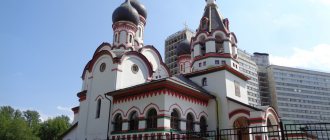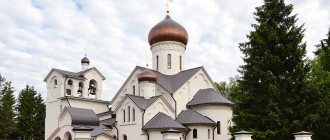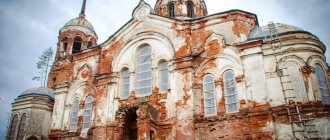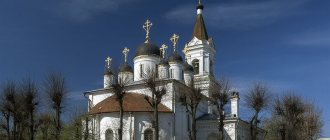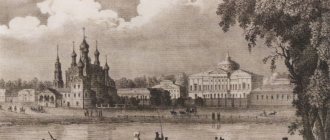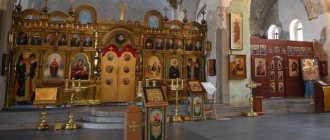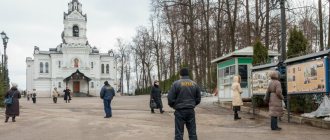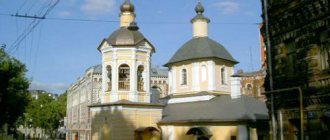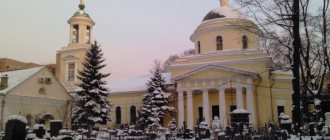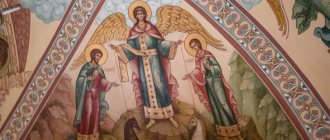| Moscow Trinity Church in Konkovo |
Moscow Church of the Life-Giving Trinity in Konkovo
(St. Andrew's Deanery of the Moscow Diocese), representative of the Chisinau-Moldavian Metropolis.
- Thrones: Life-Giving Trinity (main); St. Sergius of Radonezh (added)
- Address: Russia, 117437, Moscow, Profsoyuznaya st., 116a. (m. Konkovo)
- Tel.: 335-17-76
- Official site:
- On the map: Yandex.Map, Google map
The settlement with the estate has been known since the beginning of the 17th century.
The house church in the “Naryshkin Baroque” style was built in 1690–1694, either by G. I. Golovkin or by the okolnichy S. F. Tolochanov. Initially, the main altar was consecrated in honor of St. Sergius, the chapels - in honor of the Deposition of the Robe and St. Philip, Metropolitan of Moscow. Since 1772, the church became a parish church; two villages were added to it - Belyaevo-Dolneye and Derevlevo, which previously belonged to the Church of the Holy Trinity, on the Sparrow Hills. Due to the remoteness and inconvenient communication, the parishioners of these villages asked the Moscow diocesan authorities to assign them to the church in the village of Sergievskoye.
In 1808, the second tier of the bell tower and the refectory were built.
In 1812, Trinity Church with. Konkova was destroyed by the French retreating along the old Kaluga road and, due to the impossibility of amendment, in 1813, with the permission of the Moscow diocesan authorities, it was dismantled to the ground; the remaining material from the Trinity Church was used to build a bell tower, a fence with a holy gate and a church gatehouse at the church in the village. Sergievsky. The utensils and land were also donated to the temple. Sergievsky.
In 1818, through the zeal of the landowner Alexei Fedorovich Ladyzhensky, on the left side of the refectory church of St. Sergius of Radonezh, a chapel was built in honor of the position of the Venerable Robe of the Mother of God in Blachernae; Before the refectory was built, the landowner's parents were buried in this place. The second chapel in the name of St. Philip, Metropolitan of Moscow, was built in 1848 at the expense of the Moscow merchant Ivan Filippovich Baklanov.
In 1821, a brick fence was built around the church.
In 1939 the temple was closed. Its appearance was completely disfigured: the upper two tiers of the bell tower were destroyed, the dome with the cross and the fence were dismantled. Bells, church utensils, icons and holy books were removed. The temple building was used as a state farm warehouse; the Konkovo state farm office was located in the priest's house.
In 1960, the Konkovo district became part of the city of Moscow, the temple was included in the state lists of architectural monuments as a 17th-century monument of federal significance under No. 402: “Trinity Church in Konkovo.”
In 1967-1972 Inside the temple there was a warehouse for the Television and Technical Center.
In 1972-1973 The church was examined by specialists from the All-Union Production Research and Restoration Plant of the USSR Ministry of Culture, at the same time a restoration project was completed (the main architect of the project is S. Kravchenko) and restoration work began.
In 1982, the Television Center refused to lease the temple building and was released from responsibility for the safety of this monument, which was assigned to the regional authorities.
For a long time, the district authorities did nothing to preserve the church building, the destruction of which continued.
In 1989, the temple was going to be transferred to the laboratory of the Institute of Physics of the Earth, which had already begun restoration, based on considerations of adapting the building for its purposes. At this time, all communications were carried out to the temple.
In April 1990, services resumed in the temple.
In 1991, the temple was returned to believers.
The bell tower and domes of the temple were restored, the decoration and iconostasis were recreated.
On April 12, 2021, a representative office of the Chisinau-Moldavian Metropolis was established at the church [1].
Story
Konkovo is located in the South-West of Moscow. The first settlements in this territory date back to the 12th century. Later, several settlements existed in this area, but the largest of them were Troitskoye Konkovo and Sergievskoye Konkovo. In 1690 - 1694, the temple was built at the expense of the first chancellor of the Russian Empire, Gavrila Ivanovich Golovkin, the closest associate of Peter the Great.
Church of the Life-Giving Trinity in Konkovo
After this, the history of the Trinity Church in Konkovo developed as follows:
- The temple was built in the Naryshkin Baroque style and until 1772 it was a brownie with a main altar in honor of St. Sergius of Radonezh;
- after in 1772 the Church of the Holy Trinity in Konkovo became a parish church, combining two villages, Belyaevo-Dolnevo, Derevlevo, and at the same time the name of the temple changed;
- in 1808, a refectory was added to the temple, and the bell tower was increased by one tier;
- in 1812, the Church of the Life-Giving Trinity in Konkovo was destroyed by the French in 1812;
- the remains of the temple were dismantled and transferred for the construction of a bell tower, holy gates and a temple fence in the village. Sergievskoe;
- the further history of the church is very contradictory; according to sources, it is not clear when exactly the temple was restored, but nevertheless, in 1818 the church existed in the same place and in 1821 a stone fence was erected around it.
The last significant reconstructions that influenced the appearance of the Trinity Church in Konkovo were carried out in 1848, when, with the money of the Moscow merchant Ivan Baklanov, another chapel was built, consecrated in honor of St. Philip, Metropolitan of Moscow. During Soviet times, the temple operated until 1939, when it was closed; its further fate was as follows:
- until 1967 there was a state farm warehouse here;
- from 1967 to 1982, the warehouse of the Television Center, the latter refused the lease exactly this year, and the Church of the Life-Giving Trinity in Konkovo was empty for a long time, gradually collapsing.
In 1989, they decided to transfer the building of the former church to a scientific laboratory and for the first time, all communications were carried out. But Trinity Church was not destined to become a scientific institution; in 1991 it was returned to believers. Although services there resumed in 1990.
Important fact! It was in the first years after its closure that the temple was severely disfigured and lost its former appearance: the domes were dismantled, crosses were removed, the fence was dismantled, two tiers of the bell tower were destroyed.
More about Moscow churches:
- Church of the Life-Giving Trinity in Ostankino
- Resurrection Cathedral in Tutaevo
- St. Vladimir's Cathedral in Liski
Church of the Life-Giving Trinity in Konkovo
Church of the Life-Giving Trinity in Konkovo
received dedication to the Trinity only in 1991, but it was erected in 1690-1694. like the temple of St. Sergius of Radonezh.
At the end of the 17th century, the Serino estate in the area of modern Konkovo (then the area was called Sosensky Stan) was owned by the son of the steward Fyodor Tolochanov, Semyon. It was he who, in 1690, started the construction in his village of a stone house church in the Naryshkin Baroque style, completed by 1694 and consecrated in the name of Sergius, the Wonderworker of Radonezh. Thanks to this temple, the village began to be called Sergievsky.
1935
There was no bell tower in the temple at that time, but this does not mean at all that there were no bells. The belfry was simply located right on the southern wall of the church, with a staircase leading to it from the choir. The altar of the Sergius Church was directed strictly to the northeast, towards the Trinity-Sergius Monastery.
Some historians attribute the construction of this temple to G.I. Golovkin, pointing to his possession of the Konkovo wasteland in 1689. However, in Golovkin’s possessions at that time there was already a Church of the Life-Giving Trinity, so he had no need for another temple. The Church
of the Life-Giving Trinity in Konkovo
owes its current name and consecration to the existence of this church.
Before painting
In 1772, due to the increase in peasants assigned to the parish of the Sergius Church, the Church of Sergius of Radonezh became a parish church. At the beginning of the 19th century. (around 1808) a warm stone refectory and a three-tiered stone bell tower were added to it, which had classicist features that were clearly dissonant with the Baroque building of the main temple. During construction, the graves of the former owners of the village, the Ladyzhensky spouses, were discovered, buried near the western wall of the church. Their son A.F. Ladyzhensky in 1818 built a chapel over the grave of his parents on the left side of the refectory in honor of the Deposition of the Venerable Robe of the Mother of God in Blachernae (Deposition of the Robe), the altar of which was located directly above the graves.
1987 Before transmission to believers
In 1803, the Konkovskaya Holy Trinity (Life-Giving Trinity) Church was assigned to the Sergius parish. In 1812, it suffered so much from the French invasion that there was no point in restoring it. Therefore, the remains of the building were dismantled in 1821 and the resulting bricks were used to build a fence around the Church of St. Sergius of Radonezh.
In 1848, the Moscow merchant Ivan Filippovich Baklanov donated a rather large sum to the Sergius Church for the construction of another (right) chapel - in the name of Metropolitan Philip of Moscow, who was the patron saint of Baklanov’s father.
In the Sergius Church there was a particularly revered icon of St. Sergius with a piece of his relics. It is she who is credited with the miraculous deliverance of the residents of Konkovo from the cholera epidemic that raged in those places in 1848. In the villages of the parish, only 3 people died from the disease, while in the neighboring ones entire households died out.
1980s
In 1939, the godless authorities closed the Church of St. Sergius of Radonezh and used it as a warehouse (first for a state farm, then for a television center). Its appearance was disfigured, the altar was desecrated, and the very name of the church was completely erased from people’s memory, so that when Konkovo became part of the city in 1960, no one remembered in whose honor the church was there. Attempts to restore it as an architectural monument were sluggish and ineffective.
In 1990, when the temple was handed over to believers, no one remembered that Konkovo consisted of two parts - Konkovo-Sergievsky and Konkovo itself (Konkovo-Trinity), and all ancient sources indicated that the Church of the Life-Giving Trinity stood in Konkovo. This is how it happened that the Sergius Church was mistaken for something completely different. So it was transferred to the Russian Orthodox Church - as the Church of the Holy Trinity in Konkovo. And only later the truth was revealed. Now the main altar of the temple is consecrated in the name of the Life-Giving Trinity, and the chapels - in the name of St. St. Sergius of Radonezh and the Deposition of the Robe.
The first liturgy was celebrated on Easter 1991. The restoration of the temple lasted for many years. In 1994, when the temple celebrated its 300th anniversary, one of the Moscow clergy painted a temple image of St. Sergius. Only in 1998 did gilded crosses shine over the restored temple and bell tower and bells began to sound.
In 1993, a sisterhood was created at the church in the name of the Blachernae Icon of the Mother of God, whose special concern was Children's Home No. 9 for orphans with disorders of the nervous system and musculoskeletal system, and boarding school No. 7.
Current state
After the return of the temple, it was quickly restored - the bell tower was rebuilt, domes were erected, and a beautiful iconostasis was installed.
Iconostasis of the Church of the Life-Giving Trinity
In terms of its architecture, the temple belongs to the style called “Naryshkino Baroque”, and it is characterized by the following features:
- patterned external design;
- a mixture of different styles (Baroque, Gothic, Mannerism and others);
- excessive detailing of various elements of the building;
- traditional Russian floral ornament made in baroque style.
All these moments of the “Naryshkin baroque” are also present in the appearance of the church.
Notes[ | ]
- ↑ 1 2 3 N.P. InfoRost.
GPIB |
Vol. 8: Pekhryanskaya tithe (Moscow district). - 1892. (undefined)
. elib.shpl.ru. Access date: January 10, 2021. - 169 (undefined)
. enc.biblioclub.ru. Access date: January 10, 2021. - At the Church of the Life-Giving Trinity in Konkovo, Moscow, a Representation of the Chisinau-Moldavian Metropolis (undefined)
. Moscow Patriarchate (04/15/2021). Access date: April 30, 2021. - Clergy - Konkovo (undefined)
. Access date: July 11, 2021. - Two clergy of the Russian Orthodox Church died on May 13 from coronavirus (unspecified)
. TASS (13.05.2020). Date accessed: May 14, 2021.
Activities of the parish
Like any Moscow church located in the center of a microdistrict, the clergy of the Konkovo parish is not limited to divine services, but also organizes various other types of work aimed at educational and social-charitable activities.
- There is a Sunday school for both children and adults.
- A parish library has been opened, which is regularly replenished, including through donations from parishioners.
- Conversations are held every week.
Parishioners also visit a nursing home, a boarding school for mentally retarded children and an orphanage.
Patronal holidays
The main altar is consecrated in honor of the Holy Trinity, the celebration takes place on the 50th day after Easter. There are two more chapels:
- St. Sergius of Radonezh, October 8th is the day of the saint’s death, and July 18th the day of the discovery of his relics;
- position of the Robe of the Mother of God in Blachernae, this is the outer garment of the Mother of God, which she gave to one girl shortly before her Assumption, in the family of this girl the chasuble was kept until the 5th century, until it was found and placed in the Blachernae Church of the Mother of God in Constantinople, the feast of the placement of the Robe celebrated on July 15th.
Divine service at Trinity Church
The holiday itself is directly connected with Russia. In 860, a huge army of Rus, led by Askold, besieged Constantinople. The then Patriarch of Constantinople, Photius, walked around the walls of the city in a religious procession and lowered its edge into the waters of the Bosphorus Bay. After this, a miracle happened - the Russians lifted the siege and peace negotiations began, as a result of which Askold and his brother Dir, as well as part of their squad, accepted Baptism, which was called the First or Photius.
Clergy[ | ]
Abbots
- 1704—1709 Ivan Ilyin
- 1747 Dmitry Savinov[1]
- From August 1990 to March 1991 - Priest Valentin;
- from March 1991 to 1998 - priest Georgy Krasnolozhkin;
- since 1998 - abbot Maxim (Ryzhov).
Clerics[4]
- Hegumen Maxim (Ryzhov), rector;
- Archpriest Alexey Penkov (died on May 13, 2021 from complications caused by coronavirus infection[5]);
- priest Gregory of Smolensk;
- Protodeacon Alexander Volkov.
Worship[ | ]
Divine services: daily - Matins, Liturgy at 8:00; on Sundays and holidays - liturgy at 7:00 and 10:00, the day before - all-night vigil at 17:00, on Sunday - akathist to the Life-Giving Trinity and St. Sergius of Radonezh at 17:00.
